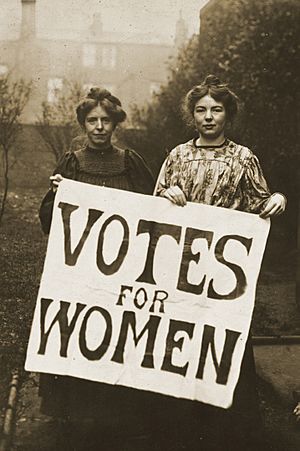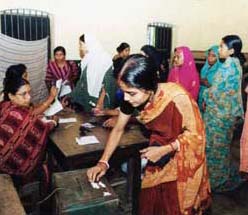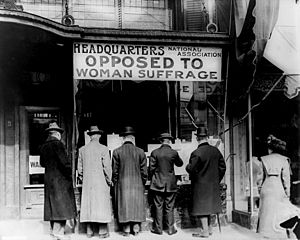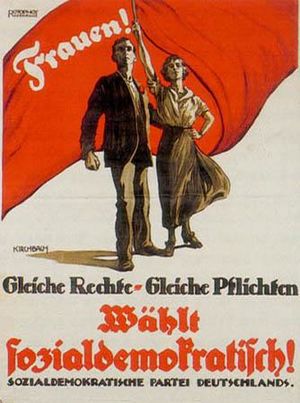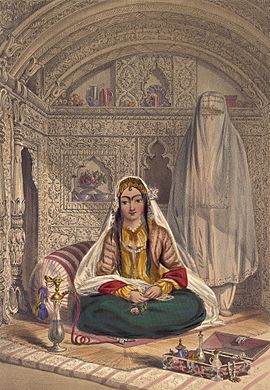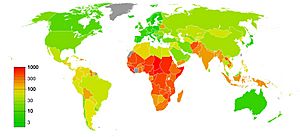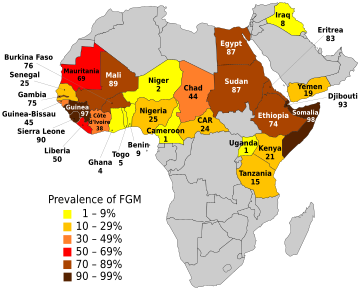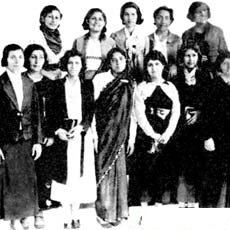Women's rights facts for kids
Women's rights are the basic freedoms and fair treatment that women and girls around the world should have. These ideas led to important movements like the women's rights movement in the 1800s and the feminist movements in the 1900s and 2000s. In some places, these rights are protected by law. In others, they are ignored or even stopped. Women's rights are different from general human rights because they focus on how women and girls have historically been treated unfairly compared to men and boys.
Common women's rights include the right to control one's own body, to be safe from violence, and to vote. They also include the right to hold public jobs, to make legal agreements, and to have equal rights in family law. Women should also have the right to work, to earn fair wages or equal pay, and to make choices about their reproductive rights. Owning property and getting an education are also key women's rights.
Contents
Equal Opportunities for Women
Fair Pay and Jobs
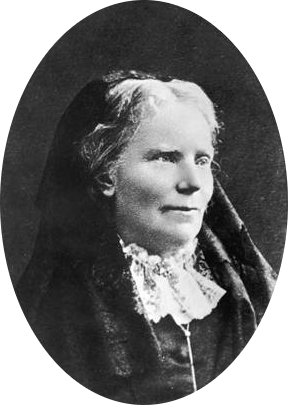
Women's rights in jobs mean they should have fair access to work and equal pay. For example, in British Hong Kong, women were not paid the same as men until the early 1970s. A person named Leslie Wah-Leung Chung helped change this. He also helped married women become permanent employees. Before this, married women often lost their permanent jobs or even their pensions. Since many nurses were women, this change helped them a lot.
In some European countries, married women could not work without their husband's permission until recently. This was true in France until 1965 and in Spain until 1975. Also, a practice called "marriage bars" stopped married women from working in many jobs. This happened in many countries, including Austria and Australia, from the late 1800s to the 1970s.
A big part of making workplaces fair for women is respecting maternity rights and reproductive rights. Maternity leave is a temporary break from work given to mothers before and after childbirth. This helps the mother recover and gives her time to care for her baby. Some countries also offer paternity leave for fathers and general parental leave.
Rules for maternity and parental leave are different in each country. In the European Union, countries must follow basic rules from the Pregnant Workers Directive and Work–Life Balance Directive.
The Right to Vote
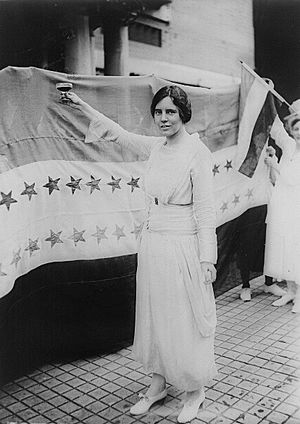
In the 1800s, some women started to ask for, demand, and then protest for the right to vote. This meant they wanted to take part in their government and help make laws. Other women, like Helen Kendrick Johnson, did not support this. She argued in 1897 that women could be equal without voting.
The idea of women's suffrage grew along with the idea of universal suffrage (everyone voting). Today, women's suffrage is seen as a basic right. In the 1800s, more and more countries started allowing more people to vote. Women began to campaign for their right to vote. In 1893, New Zealand was the first country to let women vote at a national level. Australia followed in 1902.
Many Nordic countries gave women the right to vote in the early 1900s: Finland (1906), Norway (1913), and Denmark and Iceland (1915). After World War I, many other countries followed. These included the Netherlands (1917), Austria, Canada, Germany, and the United States (1920). Some European countries were later, like Greece in 1952 and Switzerland in 1971.
In Canada, most provinces gave women the right to vote between 1917 and 1919. Quebec was later, in 1940. In Latin America, countries like Brazil (1932) and Argentina (1946) gave women the vote in the first half of the 1900s. In India, women gained the right to vote in 1935 under colonial rule. Other Asian countries like Japan (1945) and China (1947) followed. In Africa, women usually got the right to vote at the same time as men, for example, in Liberia (1947) and Nigeria (1960). In some Middle Eastern countries, like Kuwait, women gained the right to vote more recently, in 2005.
Property Rights
In the 1800s, women like Ernestine Rose and Elizabeth Cady Stanton in the United States and Britain began to challenge laws that stopped them from owning property once they married. Under an old law called coverture, husbands took control of their wives' land and earnings. Starting in the 1840s, new laws called the Married Women's Property Acts were passed. These laws protected women's property from their husbands and their husbands' debts.
In the 1800s, courts in the U.S. also required "privy examinations" for married women selling property. This meant a judge would privately ask the woman if her husband was forcing her to sign the papers. Property rights for women were limited in many European countries until the 1960s and 70s. For example, in West Germany, laws about inheriting farms favored male heirs until 1963. In the U.S., "Head and master" laws gave husbands full control of family property. These laws were common until a few decades ago, but the Supreme Court declared them unconstitutional in 1981.
Freedom to Move Around
The right to move freely is a very important right. However, in many parts of the world, women's movement is greatly limited by laws or customs. For example, in some countries, women cannot leave home without a male guardian or their husband's permission. The personal law in Yemen says a wife must obey her husband and cannot leave home without his consent. Even where there are no legal limits, social or religious customs like purdah can stop women from moving freely.
Laws restricting women from traveling existed until recently in some Western countries. Until 1983, in Australia, a married woman's passport application needed her husband's approval. Several Middle Eastern countries still have a male guardianship system. This means women need permission from a male family member for many things, including traveling. In August 2019, Saudi Arabia ended its male guardianship laws, allowing women to travel alone.
Historically, practices like foot binding also limited women's movement. This was a custom in China where young girls' feet were tightly bound, causing pain and making it hard to walk. This was common from the 900s to the 1900s.
Women's freedom to move can be limited by laws, but also by how people view women in public. In places where it's not socially accepted for women to leave home, women who are outside might face insults, harassment, or violence. Many of these limits on women's movement are said to be for "protecting" women.
Knowing Your Rights
Many women, especially in developing countries, do not know their legal rights. This makes it hard for them to improve their lives. International groups like the United Nations say that countries must not only pass laws but also tell women about these laws. This helps women seek justice and use their rights. Countries should explain laws clearly to the public to prevent misunderstandings or false beliefs about them.
The United Nations Development Programme says that to achieve fairness for women, "Women must know their rights and be able to access legal systems." The 1993 UN Declaration on the Elimination of Violence Against Women also states that countries should inform women of their rights to get help through legal systems.
Stopping Unfair Treatment
Women's rights movements work to end discrimination against women. The European Court of Human Rights says that freedom from discrimination means countries must treat people in similar situations the same way. But it also means treating people in different situations differently. This is about fairness, not just "equality." So, countries sometimes need to treat women and men differently. For example, they might offer maternity leave or other legal protections for pregnancy and childbirth. This considers the biological facts of reproduction. They might also recognize specific historical unfairness.
Countries must also treat healthcare differently by making sure women's health is not ignored. This is especially true for reproductive health like pregnancy and childbirth. The World Health Organization says that unfair treatment in healthcare often happens when a person or group is denied access to health services that others can get. It can also happen when services only needed by certain groups, like women, are denied. If countries do not recognize women's specific needs, like investing in reducing maternal mortality (deaths during childbirth), it can be a form of discrimination. Treating women and men exactly the same does not work here because pregnancy, childbirth, and breastfeeding, as well as certain medical conditions, only affect women.
The Committee on the Elimination of Discrimination against Women says that countries should check laws that seem neutral but might actually create or continue unfairness for women. They should change or remove these laws if they do. Another example of a seemingly neutral policy that harms women is when medicines are tested only on men in medical trials. Then, these medicines are used on women, assuming there are no biological differences.
The Right to Health
Health means being completely well physically, mentally, and socially, not just not being sick. Women's health refers to the health of women, which is different from men's health in many unique ways.
Women's health is seriously harmed in some parts of the world. This is due to unfairness, women being kept at home, uncaring medical workers, women not having control over their lives, and lack of money. Denying medical services that only women need is also unfair treatment. When women's right to health is violated, it can lead to maternal death. More than 300,000 women die each year from this, mostly in developing countries. Some traditional practices also harm women's health. Around the world, young women and teenage girls are most affected by HIV/AIDS.
There are also historical cases of medical abuse against women. For example, in the 1800s, women were sometimes wrongly put into insane asylums, often by their husbands or male relatives. Elizabeth Packard was an activist who fought against this. She was wrongly committed in 1860 by her husband. She later won a lawsuit, bringing attention to the issue. Another activist was journalist Nellie Bly. In 1887, she pretended to be a patient in an asylum in New York City to show the terrible conditions there.
The Right to Education
The right to education means everyone should be able to go to school. The Convention Against Discrimination in Education says that no one should be treated unfairly in education because of their race, color, sex, language, religion, or other reasons. This is to make sure everyone has equal treatment in education.
The International Covenant on Economic, Social and Cultural Rights states that countries must make sure men and women have equal rights to all economic, social, and cultural rights. Article 13 of this document recognizes "the right of everyone to education."
Access to education for women is still limited in some parts of the world. Almost two-thirds of adults who cannot read or write are women. While women's right to academic education is very important, it is also increasingly recognized that this education needs to include human rights, non-discrimination, ethics, and gender equality. This is needed for society to truly improve.
For example, Zeid bin Ra'ad, a former United Nations High Commissioner for Human Rights, said that human rights education is important for all children. He pointed out that people with advanced degrees, like Josef Mengele or those who planned The Holocaust, still committed terrible crimes because they lacked ethics and understanding. He stressed that students need to learn about gender equality.
Family Laws
In the past, under male-dominated family law, women had very few rights. They were often controlled by their husbands or male relatives. Old legal ideas like coverture, marital power, and Head and Master laws kept women under strict control. Rules from marriage laws also affected public life, such as "marriage bars" that stopped married women from working. Practices like dowry (money or property given by the bride's family) or bride price (money or property given to the bride's family) were, and still are in some places, very common.
Some countries still require a male guardian for women today. Without this guardian, women cannot use their civil rights. Other harmful practices include marrying young girls, often to much older men.
In many legal systems, the husband had complete power over the family. For example, in Franco's Spain, even though women were expected to stay home and care for children, the father had the legal rights over the children. Until 1970, a husband could give a child up for adoption without his wife's permission. Until 1975, women in Spain needed their husband's permission (called permiso marital) for many things, including working, traveling, and owning property. Switzerland was one of the last European countries to make marriage equal for men and women. Married women's rights were very limited until 1988, when new laws gave equal rights in marriage and removed the husband's legal authority. These changes were approved by voters in 1985.
Article 16 of the Universal Declaration of Human Rights says that men and women who are old enough have the right to marry and start a family. It says they should have equal rights before, during, and after marriage. It also states that marriage should only happen with the free and full agreement of both people.
Living together without being married (called Cohabitation) and single mothers are common in some parts of the world. The Human Rights Committee has stated that it is important to accept different forms of families, including unmarried couples and single parents. It also says that women in these situations should be treated equally.
United Nations Resolution 1325
On October 31, 2000, the United Nations Security Council agreed on United Nations Security Council Resolution 1325. This was the first official legal document from the UN Security Council that requires all countries to fully respect international laws for the rights and protection of women and girls during and after armed conflicts.
Images for kids
-
Bust believed to be of Cleopatra, in Altes Museum, Berlin
-
Mary Wollstonecraft by John Opie (around 1797)
-
First page of the Declaration of the Rights of Woman and of the Female Citizen
-
A Punch cartoon from 1867 making fun of John Stuart Mill's idea to use 'person' instead of 'man' to give women the right to vote.
-
Statue in downtown Calgary of the Famous Five. An identical statue is on Parliament Hill, Ottawa.
-
A young Chinese woman who was in one of the Imperial Japanese Army's "comfort battalions" is interviewed by an Allied officer.
See also
 In Spanish: Derechos de la mujer para niños
In Spanish: Derechos de la mujer para niños
- Female education
- Gender Inequality Index
- History of feminism
- Legal rights of women in history
- List of suffragists and suffragettes
- List of women's organizations
- List of women's rights activists
- Timeline of women's legal rights (other than voting)
- Timeline of women's suffrage


